Abstract
The impacts of concrete on global warming through its use in structures such as buildings and infrastructure must be identified and better understood, as concrete is known to have a very high global warming potential (GWP). However, in contrast with ordinary on-site constructed reinforced concrete, GWPs of off-site factory-made prefabricated concrete products such as precast concrete (PC) and concrete piles that are widely used in construction are rarely evaluated, owing to the complicated manufacturing processes that make the determination of greenhouse gas emission difficult. In this study, the embodied life cycle GWPs were derived for PC and pretensioned spun high-strength concrete (PHC) piles to enable precise assessment of the global warming impact of concrete structures and the concrete industry of Korea. The determined embodied GWPs of PC and PHC piles were 1.77 × 10−1 kg CO2 eq/kg and 1.87 × 10−1 kg CO2 eq/kg, respectively. As a result, both prefabricated concrete products were determined to have high GWP due to input materials, such as cement rebars, while the GWP contributions of the off-site prefabrication processes were low. Moreover, the embodied GWPs of both prefabricated concrete products were significantly higher than those of ordinary reinforced concrete, and the impact of both products on global warming was found to be approximately 4% of the impact of the Korean concrete industry. This indicates that it is necessary to consider the impacts of the PHC pile and PC industries when assessing the impacts of greenhouse gas occurring in the concrete industry at the national level. It is expected that these findings will be widely used to obtain a more accurate assessment of the impact of concrete structures and industry on global warming.
1. Introduction
Owing to the seriousness of global warming, the Intergovernmental Panel on Climate Change report published in 2018 recommended that carbon dioxide emissions be reduced to zero by 2050 and net-zero greenhouse gas (GHG) emissions be achieved by 2063 to 2068 to limit the global temperature increase to no more than 1.5 °C []. Sixty-five countries pledged toward carbon neutrality by 2050 at the 2019 Climate Summit. Europe announced the European Green Deal for carbon neutrality by 2050, followed by similar declarations from China and the United States (US). Korea also pledged to achieve carbon neutrality by 2050 [,,,]. Before this global movement for carbon neutrality, efforts had been made in the construction sector for many years to reduce global warming with respect to buildings, and such efforts have been realized through green building certification systems, such as the US Green Building Council’s Leadership in Energy and Environmental Design (LEED) in the US and the Building Research Establishment Environmental Assessment Method in the United Kingdom (UK) [,,,]. In Korea, efforts have been made to reduce the environmental load that construction causes by implementing the Green Standard for Energy and Environmental Design (G-SEED) in 2002 [,]. In addition, the standard has been reinforced by adopting life cycle assessment (LCA) as an additional certification in G-SEED from 2016 to quantitatively evaluate environmental impacts that can be caused during the life cycle of a building [].
The LCA of a building is generally conducted for the following four stages, based on the ISO-14040 series [,]: material production, construction, operation, and dismantlement/disposal. According to several studies on building LCA, the impact due to the use of energy in the operation stage and that of the material production stage represent a large proportion of the entire life cycle of a building in terms of carbon emission [,,,]. In particular, concrete is known as a major contributor to global warming, and the production of cement, which is the main component of concrete, generates the largest amount of GHG emissions across all industries, representing 8% of total industrial emissions []. The environmental impact of the material production stage is calculated using the life cycle inventory (LCI) database (DB) of construction materials developed in each country. The global warming potential (GWP) emission factors of each construction material derived through the LCI DB play a key role in determining the global warming impact. Notably, concrete was found to be the material with the highest embodied GWP in the material production stage related to building LCAs. Similarly, concrete also has a great effect on calculating the global warming impact of concrete-based infrastructure, such as bridges, as well as buildings [,,,]. Therefore, it is important to understand the precise embodied GWPs of concrete-based products.
Meanwhile, off-site construction (OSC) has become one of the top rising topics in the construction industry due to its benefits [,,,]. Prefabrication technology such as OSC has been put forward as a major goal in the construction sector owing to its sustainability, low energy use, embodied carbon and waste reduction, as well as productivity improvement [,,,,]. Compared to on-site fabrication, prefabricated concrete products such as precast concrete (PC) and concrete piles are manufactured in off-site factories before being sent to on-site construction fields. Therefore, the global warming impact of the manufacturing process at off-site factories influences the embodied GWP of prefabricated concrete products at the material production stage.
In the case of Korea, the GWP of the material production stage of concrete structures has mostly been simply calculated by using the national LCI of ready mixed concrete (RMC) and rebars, even for prefabricated concrete products that are produced in off-site factories. However, it is not possible to calculate the precise GWP of buildings and infrastructure that are built of PCs and piles using only the LCI of RMC and rebars. In contrast with ordinary cast-in situ reinforced concrete (RC), which is made with RMC and rebars during the on-site construction phase of structures, PC and concrete piles are mostly manufactured at factories with a special manufacturing process before moving on to the construction phase. Consequently, the life cycle GWP of concrete structures that employ these products has been underestimated due to the neglect of GWPs from the prefabrication process of the concrete products.
The life cycle system boundary of a prefabricated concrete product could be different depending on whether the product is considered as a material of a structure or as a structure itself. Recent studies on carbon emission of fabricated concrete products have mostly considered the products as a structure and included the construction phase within the system boundary of building LCA [,,,,]. However, to use the life cycle GWP of concrete products as an upstream emission factor for building or infrastructure LCA, the system boundary of the concrete products should be applied for the material production stage of structures. Hence, environmental product declarations (EPD) of various fabricated concrete products certified in many countries could be used in building or infrastructure LCA as an upstream process. However, EPD data of such products are rare owing to the difficulty of collecting the field data from factories.
In this study, the embodied life cycle GWPs were derived for PC and pretensioned spun high-strength concrete (PHC) piles to enable precise global warming assessment of concrete structures and the concrete industry of Korea in the future. The life cycle process of each prefabricated concrete product was therefore defined first through actual PC and PHC pile production factories, and the data required for assessment were collected. The embodied GWP of each product was then calculated using the collected field data and LCA methodology. Finally, the appropriateness of the embodied GWPs of PC and PHC piles derived in this study was verified and discussed by comparing the embodied GWPs of prefabricated concrete products and ordinary RCs. In addition, the global warming impact of PC and PHC piles within the concrete industry of Korea is discussed. Since the Korean construction industry recently focused on developing OSC technology while global warming became a serious problem for all industries, this study provides an important framework for assessing representative GWP values for the use of construction LCA at a national level and fills the blank of emission factors of prefabricated materials.
2. Materials and Methods
This study consists of three stages: life cycle process definition and data collection, life cycle GWP assessment, and result analysis. In the life cycle process definition and data collection stage, the manufacturing processes and the input/output data of PC and PHC pile production were investigated. Embodied life cycle GWPs of PC and PHC pile production were continuously assessed, and the appropriateness of the assessed values of both productions was verified. Finally, the embodied GWPs of PC and PHC pile were comparatively analyzed with those of conventional RC. Figure 1 shows the framework of this study.
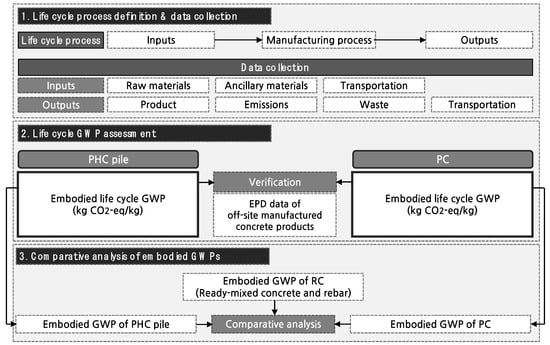
Figure 1.
Research framework.
2.1. Life Cycle Process Definition and Data Collection
In this study, the life cycle process of each material was defined, and data corresponding to each process were collected to conduct LCAs on PHC piles and PC. To ensure the reliability of the information, field data on inputs, manufacturing processes, and outputs for producing each material were collected from three representative PHC pile production factories and five PC production factories in Korea. No significant differences were found among the life cycle processes of the materials obtained from different factories. Therefore, the life cycle processes of PHC piles and PC were defined as shown in Figure 2.
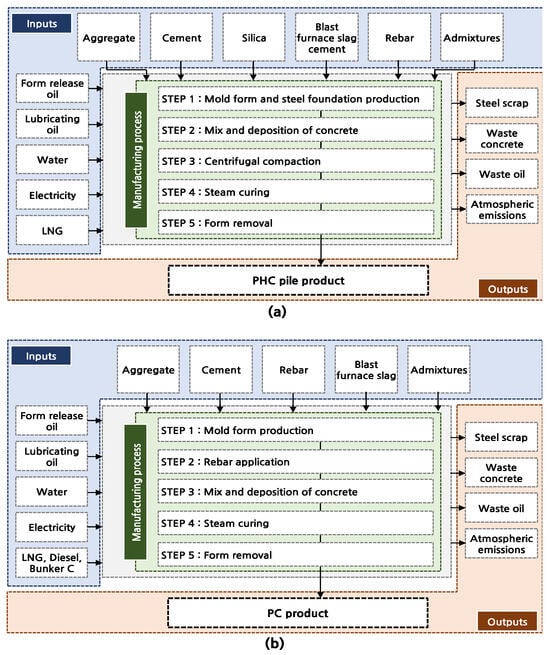
Figure 2.
Life cycle process of (a) PHC pile and (b) PC.
According to the life cycle process of each material, the inputs can be mainly divided into raw materials and ancillary materials. Both are used in the manufacturing process; however, raw materials remain in the final products, and ancillary materials do not. Ancillary materials are used in the manufacturing process among the life cycle processes, and they mostly contribute to energy supply. It was found that both PHC piles and PC consume energy for the operation of machinery and boilers for steam curing. Outputs can be mainly divided into waste, emissions, and final products. The waste materials (other than waste emissions) from all factories were transported to recycling companies for treatment. In the case of emissions, it was determined that the emission values calculated in this study should be considered as the total emission of the system boundary. As the environmental impacts of transporting materials of inputs and outputs must also be considered, information on the transport distance was investigated. Therefore, the contents to be considered for data collection were summarized, as shown in Table 1. Finally, based on the summarized considerations, the annual quantity and transport data of inputs and outputs were collected for PHC piles and PC. For all these data, annual data for 2018 were used.

Table 1.
Considerations for PHC piles and PC data collection.
2.2. Life Cycle GWP Assessment
In this study, the GWPs of PHC piles and PC were calculated using the data collected through an LCA based on the ISO-14040 series. The functional units of PHC piles and PC were set to kg, considering the unit that is generally used for EPDs of prefabricated concrete products and LCIs. Units other than the unit of this study could be used when the reference flow of piles or PC products are specified [,,]. For instance, EPDs of some precast products in Europe show detailed reference flows by defining the cross-section size and the amount of reinforcement within a unit length. In this case, the unit length of the specific product becomes the functional unit. However, because the purpose of this study is to verify the embodied life cycle GWP for general use, the reference flow was set to 1 kg without specifying the details of a specific type of product. In addition, the system boundary for deriving the life cycle GWP of each material was set from the collection of inputs, which are raw materials, to the production of 1 kg of PHC piles and 1 kg of PC to conduct the assessment. Moreover, since one of the major purposes of this study is developing representative GWP emission factors to replace the lack of LCI DBs for construction LCA, the life cycle range of the assessment was set to cradle-to-gate by following the rules of LCI DB development []. As research was conducted by collecting data from multiple off-site factories in this study, the average input and output values collected from the PHC pile and PC factories were used for GWP calculations. Table 2 shows the function, functional unit, and reference flow defined in this study.

Table 2.
Definition of function, functional unit, and reference flow.
In the ISO-14040 series, the cut-off criterion for inputs when conducting an LCA is generally the top 99% of all raw materials based on weight. In this study, the weight contribution of each raw material was calculated for cut-off, and materials not in the top 99% were excluded from the assessment. Among the collected data, the use of water was categorized based on the usage as follows: use as a raw material in each product and use as an ancillary material. As the water consumption data for each off-site factory cannot be collected separately for each product, the total annual water consumption was determined. The water consumption as a raw material was then calculated based on the average product mix proportions for each factory, and this was used for the LCA in this study. The GWP was calculated for all processes within the system boundary of PHC piles and PC, as shown in Figure 3. The national LCI DB developed by the Korean government, supported where necessary by the Ecoinvent DB version 3.3, was used for the calculations, as seen in Table 3 [,]. Consequently, the embodied life cycle GWPs of PHC piles and PC were derived based on the assessment results.

Figure 3.
System boundary of assessment.

Table 3.
List of LCI DB applied for GWP assessment.
2.3. Verification and Comparative Analysis of Embodied GWPs
In this study, the appropriateness of the assessed GWPs of PHC pile and PC production was verified by comparing the values with GWP values of other similar prefabricated concrete products. Many prefabricated concrete products in Europe, including walls, slabs, stairs, beams, and piles, have been actively certified EPDs in recent years. Referring to the International EPD System, GWP data of 53 products (20 concrete piles and 33 PC products) were collected, and the embodied GWPs for the same system boundary as this study were derived as in Table 4 []. Continually, the average GWPs of the overall 53 data, 20 concrete pile data, and 33 PC product data were calculated to compare with the embodied GWPs of PHC piles and PC derived in this study. Moreover, the data were statistically analyzed by using a box and whisker plot to find the proper GWP range and check the appropriateness of the embodied GWPs of PHC piles and PC. Additionally, this study analyzed the difference in embodied GWPs between conventional RC structures composed of 8 types of RMCs and reinforcing rebars and off-site manufactured PHC piles and PC products.

Table 4.
Embodied GWP data of EPD-certified prefabricated concrete products [].
3. Results
3.1. Life Cycle GWP Results and Impact Analysis
Among the raw materials for PHC piles and PC considered in this study, an analysis was conducted to determine the materials that should be excluded from the assessment. It was found that admixtures must be excluded for both PHC piles and PC because they were not included in the top 99% based on weight, as shown in Table 5. Accordingly, the LCAs of PHC piles and PC concrete were performed, considering the raw materials and ancillary materials other than admixtures, and the analysis results are presented in Table 6 and Table 7, respectively. For PHC piles, the process of producing cement, rebars, and slag cement, together with the input transportation and manufacturing process, represented more than 94% of the total GWP. Among them, the production of cement, which is the main raw material of PHC piles, exhibited the highest GWP. The GWPs for the production of rebars and the transportation of input materials were also high. Consequently, the calculated life cycle GWP emission of PHC piles was 1.87 × 10−1 kg CO2 eq/kg. For PC, the process of producing rebars, cement, and electricity, together with the input transportation and manufacturing process, represented more than 96% of the total GWP. Among these, the production of rebars and cement, which are the main raw materials of PC, exhibited the highest GWPs. The GWP of the electricity generation process, which is a representative ancillary input source, and that associated with the transportation of input materials were also found to be high. As a result, the calculated life cycle GWP of PC was 1.77 × 10−1 kg CO2 eq/kg. Thus, these analyzed results indicated that the improvement of the discussed processes must be considered a priority to reduce GHG emissions during the production of PHC piles and PC.

Table 5.
Materials to be included in assessment based on weight contribution.

Table 6.
Life cycle GWP assessment of PHC piles.

Table 7.
Life cycle GWP assessment of PC.
Meanwhile, as shown in Figure 4, the GWP contribution rates of off-site manufacturing processes for PHC piles and PC were 5.28% and 2.89%, respectively, among the whole life cycle GWPs. The global warming effects of the manufacturing processes, especially, were assessed very low compared to the GWP contribution rates of cement (71.53% for PHC piles and 63.63% for PC). Cement is well known to contain high levels of embodied CO2 because of the dissolution process of limestone (CaCO3), which generates CO2. However, the GWPs generated from the prefabrication process were only 7.38% (for PHC piles) and 4.54% (for PC) of the embodied GWP of cement input solely. This result implies that the off-site prefabrication process affects low GWP compared to the whole life cycle of prefabrication products and signifies the importance of reducing the embodied carbon of the inputs rather than the prefabrication processes to produce a low-carbon product.
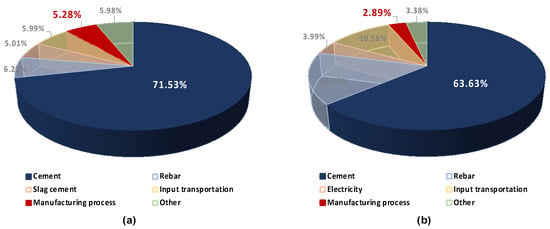
Figure 4.
Embodied GWP contribution rates of (a) PHC piles and (b) PC.
3.2. Verification of Embodied Life Cycle GWPs
To verify the appropriateness of the life cycle GWP values assessed in this study, previously assessed EPD data of prefabricated concrete products were collected and used for analysis. A total of 53 groups of data (overall data) were used, and 20 of them were concrete pile data, and 33 were PC products. The average GWPs of the overall, PCs, and concrete piles were 0.1920, 0.1798, and 0.2121, respectively, which were slightly higher than the GWPs of PC and PHC piles assessed in this study, as in Figure 5. The GWPs of PC and PHC piles assessed in this study were 7.65% and 2.37% lower than the average of overall EPD data, respectively, while the GWP of PC assessed in this study was 1.40% lower than that of PC EPD data, and the GWP of PHC pile was 11.62% lower than that of concrete pile EPD data. The GWP of PC assessed in this study was mostly similar to the estimated averages of EPD data, while the GWP of PHC piles had a difference of more than 10%.
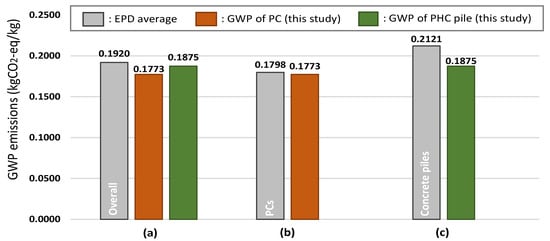
Figure 5.
Comparison of GWP values between PC and PHC piles assessed in this study and (a) overall EPD data, (b) PC EPD data, and (c) concrete pile EPD data.
However, according to the box and whisker plots in Figure 6, GWPs of both PC and PHC piles were found to be within the interquartile range (IQR) of the estimated EPD data. The estimated range of overall EPD data was 0.1675 kg CO2 eq/kg (lower quartile) to 0.2255 kg CO2 eq/kg (upper quartile), the range of PC EPD data was 0.1355 kg CO2 eq/kg (lower quartile) to 0.2255 kg CO2 eq/kg (upper quartile), and the range of concrete pile EPD data was 0.1851 kg CO2 eq/kg (lower quartile) to 0.2338 kg CO2 eq/kg (upper quartile). Compared to the gap between the GWPs of PHC piles and EPD concrete piles, the results show that the GWP of PHC piles assessed in this study is within a reliable range, as well as the GWP of PC. Therefore, it was found that the assessed embodied GWPs of both PC and PHC piles are appropriate to use in other environmental evaluations related to off-site construction.
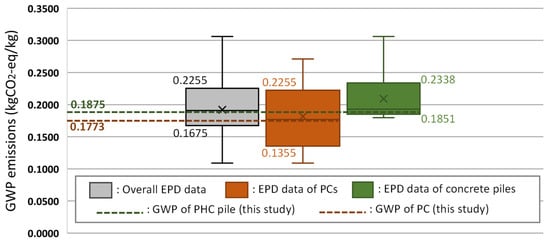
Figure 6.
Verifying the appropriate ranges of embodied GWPs for PC and PHC piles.
3.3. Comparative Analysis of GWPs
The GWPs of the material production stage of concrete structures in Korea have, up to now, been simply calculated by using the Korean national LCI of RMC and rebars, even for prefabricated concrete products such as PC and concrete piles, treating them as ordinary RC. According to the input and output data collected in this study, 1 kg of PHC piles consists of 0.97 kg of concrete and 0.03 kg of reinforcement, whereas 1 kg of PC consists of 0.94 kg of concrete and 0.06 kg of reinforcement. Figure 7 and Figure 8 compare the embodied GWPs of the conventional RC that was made in these concrete and reinforcement ratios with those of the PHC piles and PC products produced through prefabrication. To calculate the embodied GWPs of RC, the GWP emission factors for each compressive strength of RMC from Korea’s national LCI DB and those for reinforcement were applied [].
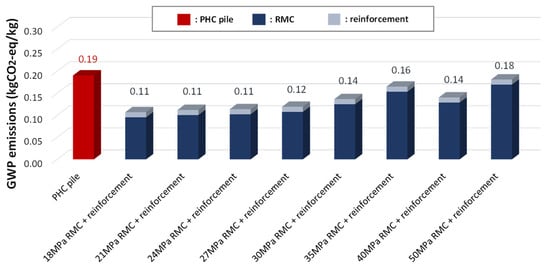
Figure 7.
Unit life cycle GWP comparison between PHC piles and RC.
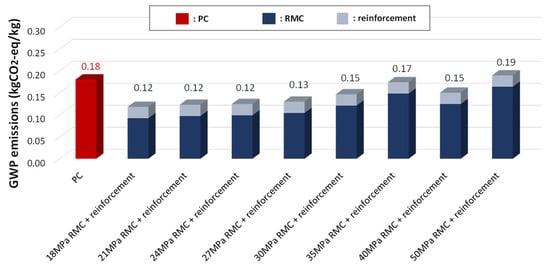
Figure 8.
Unit life cycle GWP comparison between PC and RC.
When the embodied GWPs of PHC piles and PC were assessed, it was found that both products showed generally higher embodied GWPs compared to RC produced with RMC and reinforcement. In particular, emission factors corresponding to 21 and 24 MPa were mainly applied to the LCA of fabricated structures in Korea. The GWP of RC that applied these was found to be approximately 58% of that of PHC piles and 67% of that of PC. This means that the GWP may be significantly underestimated compared to the actual GWP when the quantities of off-site prefabricated concrete products are assumed to be RC when conducting LCA on concrete structures. In addition, RC that used 50 MPa RMC showed similar values to the GWPs of PHC piles and PC within the error of 5%, indicating that it can be used as an alternative factor in the absence of the emission factors of PHC piles and PC when conducting an LCA on prefabricated concrete structures. Moreover, this also indicates that GWPs of high-strength concrete structures could be reduced by changing on-site fabrication to prefabrication because extra GWP emission during the construction stage should be considered for the on-site process, while less GWP emission will be expected for the construction stage of prefabricated structures.
3.4. Short Discussion on the Global Warming Impact of the Korean Concrete Industry
In this study, the annual GWPs were additionally calculated and compared based on the annual production of PHC piles, PC, and RMC to examine the impacts of PHC piles and PC on global warming. The GWP for the total production of each material in 2018 (the field data collection year of this study) was used, and the results are shown in Table 8. The sum of emissions from PHC piles and PC was approximately 4% of the annual impact of RMC on global warming. This is a value that cannot be neglected in the concrete industry, indicating that the impacts of the PHC piles and PC industries, as well as those of the RMC industry, should be considered when assessing the impacts of global warming that occur in the concrete industry at the national level.

Table 8.
Comparative analysis of annual total GWPs.
4. Discussion
In this study, the embodied life cycle GWPs of PHC piles and PC from a range of concrete products that constitute the main components of prefabricated structures were derived. They were compared with the embodied GWP of RMC, and it was deduced that off-site manufactured PHC piles and PC, as well as RMC, ought to be considered for the precise global warming assessment of concrete structures in Korea. It is expected that the results of this study can be a useful reference for examining the state of carbon neutrality in the construction sector amid global campaigns arising to realize carbon neutrality in industry. Specifically, in many studies in the construction sector, the total concrete consumption is still assumed to only be in the form of RC for the purposes of assessment of the impact of concrete on global warming. The embodied GWPs of PHC piles and PC presented in this study are expected to be widely used in Korea as new emission factors to obtain a more accurate assessment of the impact of concrete structures and industry on global warming.
The data used in this study were collected from certain factories; however, broader data on various kinds of concrete products from more factories are required to increase the reliability of the results. It is well known that the embodied GWP value depends highly on the characteristics of concrete, such as strength, ductility, and rigidity [,]. Moreover, the characteristics of concrete products could be classified in many ways according to the chemical compositions and input material properties [,]. Therefore, it is necessary to collect more data to calculate the GWPs of more detailed types of prefabricated concrete products in future studies.
In addition, as there may be differences in the production process and input transportation methods between countries, additional field surveys will be required to use the results of this study in countries other than Korea. In particular, the LCI DBs used in this study are mostly developed by the Korean government for use in national-level LCAs. However, many other previous studies use LCIs and emission factors referring to other studies or LCI DBs generally used in many countries [,]. Therefore, the results derived in this study are expected to be most applicable for structure LCA studies conducted in Korea, while there are some limitations in applying the results to other countries. The LCIs and emission factors should be thoroughly analyzed in further studies to derive the optimal GWP value that could be used worldwide.
5. Conclusions
In this study, the embodied life cycle GWPs were derived for PC and PHC piles to obtain a highly precise global warming assessment of concrete structures. The conclusions can be drawn as follows.
- The life cycle embodied GWPs were found to be 1.87 × 10−1 kg CO2 eq/kg for PHC piles and 1.77 × 10−1 kg CO2 eq/kg for PC;
- The GWP contribution rates of off-site manufacturing processes for PHC piles and PC were only 5.28% and 2.89%, respectively, among the whole life cycle GWPs, while the GWP contribution rates of cement input solely were 71.53% for PHC piles and 63.63% for PC. The results imply that the off-site prefabrication process affects low GWPs compared to the whole life cycle of prefabrication products and signifies the importance of reducing the embodied carbon of the inputs rather than the prefabrication processes to produce a low-carbon product;
- According to the analysis of the EPD data of prefabricated products, the accurate GWP range of overall prefabricated products was from 0.1675 kg CO2 eq/kg to 0.2255 kg CO2 eq/kg, that of PC was from 0.1355 kg CO2 eq/kg to 0.2255 kg CO2 eq/kg, and that of concrete piles was from 0.1851 kg CO2 eq/kg to 0.2338 kg CO2 eq/kg. Since the assessed GWPs of this study were within the ranges, it was found that the assessed embodied GWPs of both PC and PHC piles are appropriate to use in other environmental evaluations related to off-site construction;
- The embodied GWP of ordinary RC used for concrete structure LCA in Korea was found to be approximately 58% of that of PHC piles and 67% of that of PC. This implies that the life cycle GWPs of concrete structures may be significantly underestimated when the quantities of PC and PHC piles are assumed to be conventional RC;
- In addition, the impact of the production of PHC piles and PC on global warming in Korea was found to be approximately 4% of that of RMC. This indicates that it is necessary to consider the impacts of the PHC piles and PC industries as well as those of the RMC industry when assessing the impacts of global warming on the concrete industry at the national level.
Since the recent construction industry of Korea focuses on developing OSC technology while global warming became a serious issue for all industries, this study provides an important framework for assessing representative GWP values for the use of construction LCA at a national level and fills the blank of emission factors of prefabricated materials. For more reliable results, it is necessary to collect broader data to calculate the GWPs of more detailed types of prefabricated concrete products in future studies.
Author Contributions
Methodology, H.K.; formal analysis, H.K.; resources, H.K.; writing—original draft preparation, H.K.; writing—review and editing, H.K., J.K. and S.R.; visualization, H.K.; supervision, J.K. and S.R. All authors have read and agreed to the published version of the manuscript.
Funding
This work was supported by the Basic Science Research Program through the National Research Foundation of Korea (NRF) funded by the Ministry of Education (grant number RS-2023-00246508) and the National Research Foundation of Korea (NRF) grant funded by the Korean government (MSIT) (No. NRF-2021R1F1A1062047).
Data Availability Statement
The data used to support the findings of this study are available from the corresponding author upon request.
Conflicts of Interest
The authors declare no conflict of interest.
Abbreviations
| EPD | environmental product declaration |
| GHG | greenhouse gases |
| GWP | global warming potential |
| G-SEED | Green Standard for Energy and Environmental Design |
| LCA | life cycle assessment |
| LCI DB | life cycle inventory database |
| LEED | Leadership in Energy and Environmental Design |
| PC | precast concrete |
| PHC | pretensioned spun high-strength concrete |
| RC | reinforced concrete |
| RMC | ready mixed concrete |
References
- IPCC. An IPCC Special Report on the Impacts of Global Warming of 1.5 °C above Preindustrial Levels and Related Global Greenhouse Gas Emission Pathways, in the Context of Strengthening the Global Response to the Threat of Climate Change, Sustainable Development, and Efforts to Eradicate Poverty; Cambridge University Press: Cambridge, UK, 2018. [Google Scholar] [CrossRef]
- European Commission. Communication from the Commission: The European Green Deal; European Union: Brussels, Belgium, 2019. [Google Scholar]
- International Energy Agency (IEA). An Energy Sector Road Map to Carbon Neutrality in China; IEA: Paris, France, 2021. [Google Scholar]
- US Department of State. The Long-Term Strategy of the United States: Pathways to Net-Zero Greenhouse Gas Emissions by 2050; US Government Printing Office: Washington, DC, USA, 2021.
- Government of the Republic of Korea. 2050 Carbon Neutral Strategy of the Republic of Korea: Towards a Sustainable and Green Society; Government of the Republic of Korea: Seoul, Republic of Korea, 2020.
- Kaur, H.; Garg, P. Urban sustainability assessment tools: A review. J. Clean. Prod. 2019, 210, 146–158. [Google Scholar] [CrossRef]
- Díaz-López, C.; Carpio, M.; Martín-Morales, M.; Zamorano, M. Analysis of the scientific evolution of sustainable building assessment methods. Sustain. Cities Soc. 2019, 49, 101610. [Google Scholar] [CrossRef]
- Awadh, O. Sustainability and green building rating systems: LEED, BREEAM, GSAS and Estidama critical analysis. J. Build. Eng. 2017, 11, 25–29. [Google Scholar] [CrossRef]
- Jiménez-Pulido, C.; Jiménez-Rivero, A.; García-Navarro, J. Improved sustainability certification systems to respond to building renovation challenges based on a literature review. J. Build. Eng. 2022, 45, 103575. [Google Scholar] [CrossRef]
- Kim, H.; Park, W. A study of the energy efficiency management in Green Standard for Energy and Environmental Design (G-SEED)-certified apartments in South Korea. Sustainability 2018, 10, 3402. [Google Scholar] [CrossRef]
- Kim, K.H.; Chae, C.; Cho, D. Development of an assessment method for energy performance of residential buildings using G-SEED in South Korea. J. Asian Arch. Build. Eng. 2022, 21, 133–144. [Google Scholar] [CrossRef]
- KICT. Green Standard for Energy and Environmental Design; G-SEED. 6 (2016) v1. Korea Institute of Civil Engineering and Building Technology (KICT): Goyang, Republic of Korea, 2021. Available online: http://gseed.or.kr (accessed on 1 June 2022).
- ISO-14040; Environmental Management—Life Cycle Assessment—Principles and Framework. International Organization for Standardization (ISO): Geneva, Switzerland, 2006.
- ISO-14044; Environmental Management—Life Cycle Assessment—Requirements and Guidelines. International Organization for Standardization (ISO): Geneva, Switzerland, 2006.
- Petrovic, B.; Myhren, J.A.; Zhang, X.; Wallhagen, M.; Eriksson, O. Life cycle assessment of building materials for a single-family house in Sweden. Energy Procedia 2019, 158, 3547–3552. [Google Scholar] [CrossRef]
- Cho, S.; Chae, C. A study on life cycle CO2 emissions of low-carbon building in South Korea. Sustainability 2016, 8, 579. [Google Scholar] [CrossRef]
- Rinne, R.; Ilgın, H.E.; Karjalainen, M. Comparative study on life-cycle assessment and carbon footprint of hybrid, concrete and timber apartment buildings in Finland. Int. J. Environ. Res. Public Health 2022, 19, 774. [Google Scholar] [CrossRef]
- Ryberg, M.W.; Ohms, P.K.; Møller, E.; Lading, T. Comparative life cycle assessment of four buildings in Greenland. Build. Environ. 2021, 204, 108130. [Google Scholar] [CrossRef]
- Ellis, L.D.; Badel, A.F.; Chiang, M.L.; Park, R.J.; Chiang, Y.M. Toward electrochemical synthesis of cement—An electrolyzer-based process for decarbonating CaCO3 while producing useful gas streams. Proc. Natl. Acad. Sci. USA 2020, 117, 12584–12591. [Google Scholar] [CrossRef] [PubMed]
- Penadés-Plà, V.; Martí, J.V.; García-Segura, T.; Yepes, V. Life-cycle assessment: A comparison between two optimal posttensioned concrete box-girder road bridges. Sustainability 2017, 9, 1864. [Google Scholar] [CrossRef]
- Martínez-Muñoz, D.; Martí, J.V.; Yepes, V. Comparative life cycle analysis of concrete and composite bridges varying steel recycling ratio. Materials 2021, 14, 4218. [Google Scholar] [CrossRef] [PubMed]
- Kim, K.J.; Yun, W.G.; Cho, N.; Ha, J. Life cycle assessment based environmental impact estimation model for pre-stressed concrete beam bridge in the early design phase. Environ. Impact Assess. Rev. 2017, 64, 47–56. [Google Scholar] [CrossRef]
- Park, W.-J.; Kim, R.; Roh, S.; Ban, H. Analysis of major environmental impact categories of road construction materials. Sustainability 2020, 12, 6951. [Google Scholar] [CrossRef]
- Wang, Z.; Hu, H.; Gong, J.; Ma, X.; Xiong, W. Precast supply chain management in off-site construction: A critical literature review. J. Clean. Prod. 2019, 232, 1204–1217. [Google Scholar] [CrossRef]
- Haar, B.T.; Kruger, J.; Zijl, G. Off-site construction with 3D concrete printing. Autom. Constr. 2023, 152, 104906. [Google Scholar] [CrossRef]
- Jayawardana, J.; Sandanayake, M.; Jayasinghe, J.A.S.C.; Kulatunga, A.K.; Zhang, G. A comparative life cycle assessment of prefabricated and traditional construction—A case of a developing country. J. Build. Eng. 2023, 72, 106550. [Google Scholar] [CrossRef]
- Arslan, D.; Sharples, S.; Mohammadpourkarbasi, H.; Khan-Fitzgerald, R. Carbon Analysis, Life cycle assessment, and Prefabrication: A Case Study of a High-Rise Residential Built-toRent Development in the UK. Energies 2023, 16, 973. [Google Scholar] [CrossRef]
- Teng, Y.; Li, K.; Pan, W.; Ng, T. Reducing building life cycle carbon emissions through prefabrication: Evidence from and gaps in empirical studies. Build. Environ. 2018, 132, 125–136. [Google Scholar] [CrossRef]
- Sandanayake, M.; Zhang, G.; Setunge, S.; Thomas, C.M. Environmental emissions of construction equipment usage in pile foundation construction process—A case study. In Proceedings of the 19th International Symposium on Advancement of Construction Management and Real Estate; Springer: Berlin, Germany, 2015; pp. 327–339. [Google Scholar] [CrossRef]
- Li, X.-J.; Zheng, Y.-D. Using LCA to research carbon footprint for precast concrete piles during the building construction stage: A China study. J. Clean. Prod. 2020, 245, 118754. [Google Scholar] [CrossRef]
- Lyu, F.; Shao, H.; Zhang, W. Comparative analysis about carbon emission of precast pile and cast-in-situ pile. Energy Rep. 2022, 8, 514–525. [Google Scholar] [CrossRef]
- Sandanayake, M.; Zhang, G.; Setunge, S. Environmental emissions at foundation construction stage of buildings: Two case studies. Build. Environ. 2016, 95, 189–198. [Google Scholar] [CrossRef]
- Luo, W.; Sandanayake, M.; Zhang, G. Direct and indirect carbon emissions in foundation construction-Two case studies of driven precast and cast-in-situ piles. J. Clean. Prod. 2019, 211, 1517–1526. [Google Scholar] [CrossRef]
- Ministry of the Environment (ME). Environmental Product Declaration Guideline, 2021. Maine, Republic of Korea: Annex 2 Transport Distance. 2021. (In Korean). Available online: https://www.law.go.kr/LSW/admRulInfoP.do?admRulSeq=2100000199570#AJAX (accessed on 1 May 2022).
- EPDDANMARK. EPD Database—Precast Lightweight Concrete Wall Elements. 2021. (In Danish). Available online: https://www.epddanmark.dk/media/oq0dzm1j/md-20015-da_rev1-betonelement-foreningen.pdf (accessed on 1 May 2022).
- EPDDANMARK. EPD Database—Precast Reinforced Concrete Piles. 2021. (In Danish). Available online: https://www.epddanmark.dk/media/g05hrtkm/md-21004-da_centrum-p%C3%A6le.pdf (accessed on 1 May 2022).
- The Norwegian EPD Foundation. Precast Concrete One-Layer Elements. 2020. Available online: https://www.epd-norge.no/getfile.php/1312712-1583419315/EPDer/Byggevarer/Betongvarer/NEPD-2062-930_Precast-Concrete-One-Layer-Elements--.pdf (accessed on 1 May 2022).
- Korea Environmental Industry & Technology Institute (KEITI). National LCI DB. 2022. (In Korean). Available online: https://www.greenproduct.go.kr/epd/lci/lciDb.do (accessed on 1 April 2022).
- Ecoinvent. Ecoinvent v3.3; Ecoinvent: Zürich, Switzerland, 2016. Available online: https://ecoinvent.org/the-ecoinvent-database/data-releases/ecoinvent-3-3/ (accessed on 1 December 2019).
- The International EPD System. EPD International AB, Sweden. Available online: https://www.environdec.com/home (accessed on 17 September 2023).
- Korea Environmental Industry & Technology Institute (KEITI). Environmental Product Declaration Certified Products. 2022. (In Korean). Available online: https://www.greenproduct.go.kr/epd/carbon/productStatusList.do (accessed on 1 May 2022).
- Müller, H.S.; Breiner, R.; Moffatt, J.S.; Haist, M. Design and properties of sustainable concrete. Procedia Eng. 2014, 95, 290–340. [Google Scholar] [CrossRef]
- Bhagat, G.V.; Savoikar, P.P. Auditing carbon reduction potential of green concrete using life cycle assessment methodology. IOP Conf. Ser. Earth Environ. Sci. 2021, 850, 012002. [Google Scholar] [CrossRef]
- Pishro, A.A.; Feng, X.; Ping, Y.; Dengshi, H.; Shirazinejad, R.S. Comprehensive equation of local bond stress between UHPC and reinforcing steel bars. Constr. Build. Mater. 2020, 262, 119942. [Google Scholar] [CrossRef]
- Zahedi, M.; Ramezanianpour, A.A.; Ramezanianpour, A.M. Evaluation of the mechanical properties and durability of cement mortars containing nanosilica and rice husk ash under chloride ion penetration. Constr. Build. Mater. 2015, 78, 354–361. [Google Scholar] [CrossRef]
- Mao, C.; Shen, O.; Shen, L.; Tang, L. Comparative study of greenhouse gas emissions between off-site prefabrication and conventional construction methods: Two case studies of residential projects. Energy Build. 2013, 66, 165–176. [Google Scholar] [CrossRef]
- Wen, T.J.; Siong, H.C.; Noor, Z.Z. Assessment of embodied energy and global warming potential of building construction using life cycle analysis approach: Case studies of residential buildings in Iskandar Malaysia. Energy Build. 2015, 93, 295–302. [Google Scholar] [CrossRef]
Disclaimer/Publisher’s Note: The statements, opinions and data contained in all publications are solely those of the individual author(s) and contributor(s) and not of MDPI and/or the editor(s). MDPI and/or the editor(s) disclaim responsibility for any injury to people or property resulting from any ideas, methods, instructions or products referred to in the content. |
© 2023 by the authors. Licensee MDPI, Basel, Switzerland. This article is an open access article distributed under the terms and conditions of the Creative Commons Attribution (CC BY) license (https://creativecommons.org/licenses/by/4.0/).